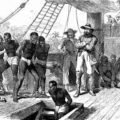The Khoikhoi – meaning “men of men” or “real people”, or Khoekhoe as the name is
spelt in Nama orthography, were closely related to the San and they lived in southern
Africa since the 5th century AD. M-L. Wilson writes in the South African
archaeological Bulletin that there is current consensus among scholars that the
Khoikhoi originated in a region centred around the junction between Zambia,
Zimbabwe and Botswana. It is possible that the Khoikhoi developed their pastoral
culture about 2 000 years ago through contact with migrating Bantu groups from the
north who were travelling down through Africa with domesticated herds of cattle,
sheep and goats.
Archaeological evidence shows that the Khoikhoi entered South Africa from Botswana through two distinct routes – travelling west, skirting the Kalahari, to the west coast, then down to the cape. They also entered through the south-east into the Highveld and then southwards to the coast. When the European immigrants colonised the cape in 1652, the khoikhoi were already practising extensive pastoral agriculture in the area with large herds of Nguni cattle. The European immigrants labelled them “Hottentots” in imitation of the sound of the Khoekhoe language, but this term is today considered derogatory. As the Dutch took over land for farms, the Khoikhoi were dispossessed, exterminated or enslaved and smallpox, which was brought by the Boers, sharply dwindled their numbers





Latest Comments